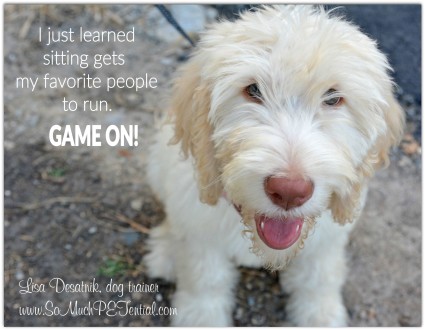The other day, I had a second training session with this adorable labradoodle puppy and his family. He laid patiently at their side while we began talking through solving the issues that come with bringing a young, energetic companion into their home with sharp teeth and an incomplete understanding of human household etiquette. (It is so awesome that their whole family is on board and eager to learn about training.)
 Then we got up to work on actual training. After their practicing some hand targeting and name game exercises, we started doing some work on building value for his sit behavior. Initially they were using treats as a reinforcers; however, he was noticing more of the environment than of his teachers, and being slow at offering the sit.
Then we got up to work on actual training. After their practicing some hand targeting and name game exercises, we started doing some work on building value for his sit behavior. Initially they were using treats as a reinforcers; however, he was noticing more of the environment than of his teachers, and being slow at offering the sit.
Remember, this is a little guy who was born to play and who had just spent over a half hour in the car followed by time resting. He was ready for activity.
So, I wanted to show another approach. I stood in the center of the room and when he followed and sat at my side, the second his rear end touched the ground, I proclaimed, ‘Yes!’ and then proceeded to run and grabbed a tug toy.
As just about any labradoodle puppy will do, he began chase. It was Game On! In just a couple of seconds, I stopped movement. He responded by putting his rear end back on the ground, and I immediately marked that behavior again with Yes! and began moving again. We even worked in some initial tug game rules (adding the cue ‘get it’ before giving him the tug and then teaching the ‘out cue – but tugging will be another topic for another post).
All of a sudden this puppy who was uninterested in his classroom became a straight A student.
So, I thought I’d talk a little about why this happened and some of the lessons here about training.
Firstly, as our pet’s teachers it should always be our goal to figure out how we can make our lesson plan clear and understandable for animals who do not speak our language. In this case, practicing capturing the sit behavior, marking it and reinforcing it with many successful repetitions in their home with low distraction will help to build fluency with sit (part of this family’s homework).
Timing is important to teaching with clarity. Especially since non-human animals do not speak English (or other human language), marking the very specific behavior you are reinforcing tells learners, “Yes, what you just did this second was exactly what I was looking for.” Without good timing on your part, you may inadvertently teach behaviors you do not want to see.
Motivation is another important concept to keep in mind in training. Remember, when given choices, animals will choose to do behaviors that get them the most valued consequences. It is our job as their teacher to figure out how to make the behavior choices we want to see, the most valuable choices for each learner. And that changes all the time. Probably a dog will value chicken or meat over dry dog food, and my bird Barnaby will value a piece of cream cheese over a pellet. After a big meal, an animal may be less motivated by food. After a long exercise (and once settled), an animal will probably be less motivated to do activities and value resting instead. On the other hand, after a long nap, a puppy is going to be ready to play. A dog sitting at a door may value the opportunity for smelling flowers or running in the grass.
By being aware of what your pet values, you can increase the value of the behavior you are teaching by following it with (or I should say, marking the behavior with a click or verbal word that is followed by) a highly reinforcing consequence. (In this case, that consequence is the opportunity to chase or tug.) And with enough pairing of the behavior such as sit with a valued consequence such as meat, a game of tug or a game of chase, the less probable behavior (like sit) will become more probable.
The Sit Means Play Game
This game is actually terrific for teaching several skills in addition to sit. It works on self control and the ability to turn on and off active movement. You can also build up to working on duration as you wait longer in between marking and releasing the behavior to play.
Steps simplified:
- Initially capture your pet sitting
- Mark that behavior (such as either a verbal marker such as ‘Yes!’ or a click)
- Follow the mark with a game of chase, tug or something else (for no more than a few seconds)
(NOTE: in the beginning you will want to stop this game before your dog becomes too aroused) - Then stop and stand still
- When your pet sits, go through the steps again
Variations of this game can include different reinforcers such as the opportunity while on leash to greet someone or sniff the grass, the opportunity to get a leash attached, or any activity that gets your dog’s tail wagging.
Here is a video of me using this game to give our Sam the opportunity to run find treats.
As always..remember to have fun!






